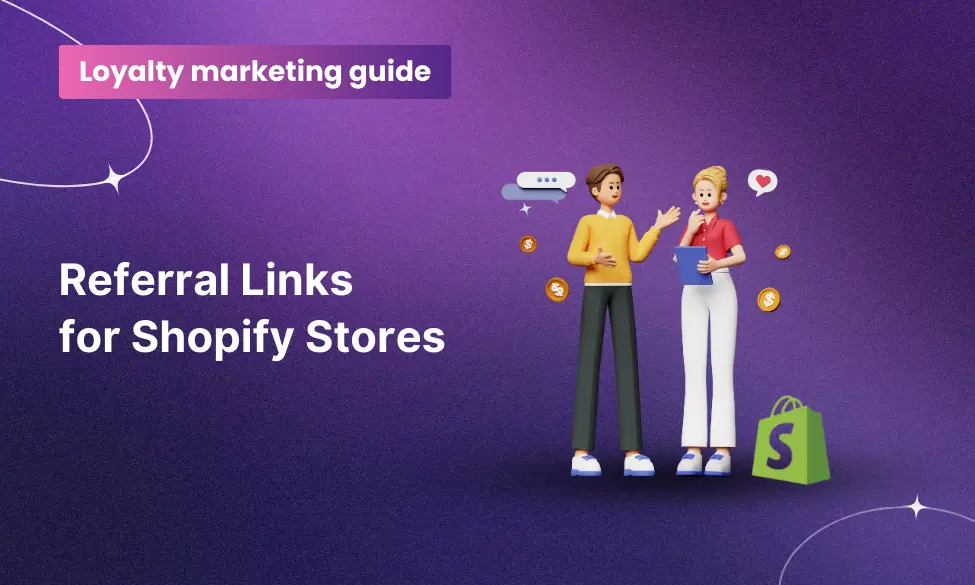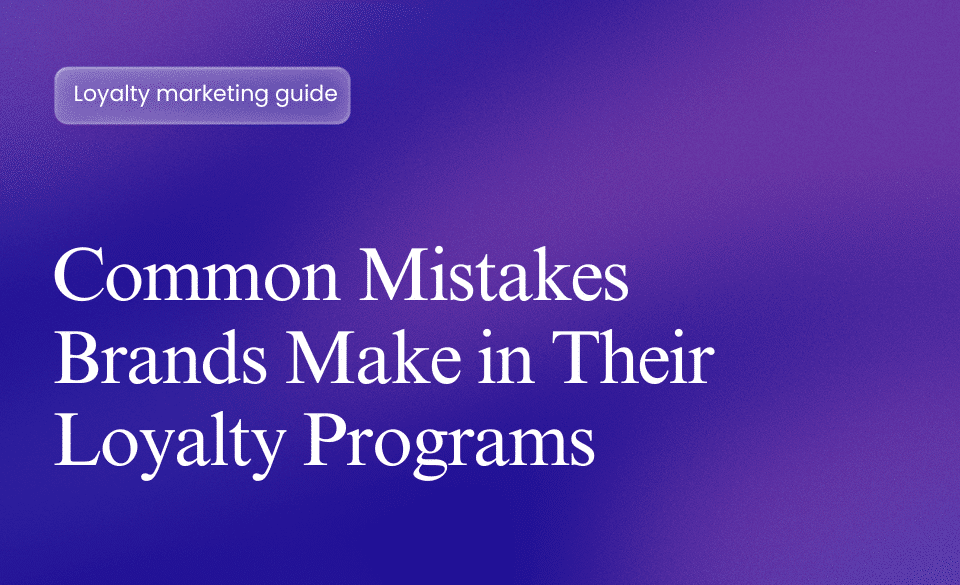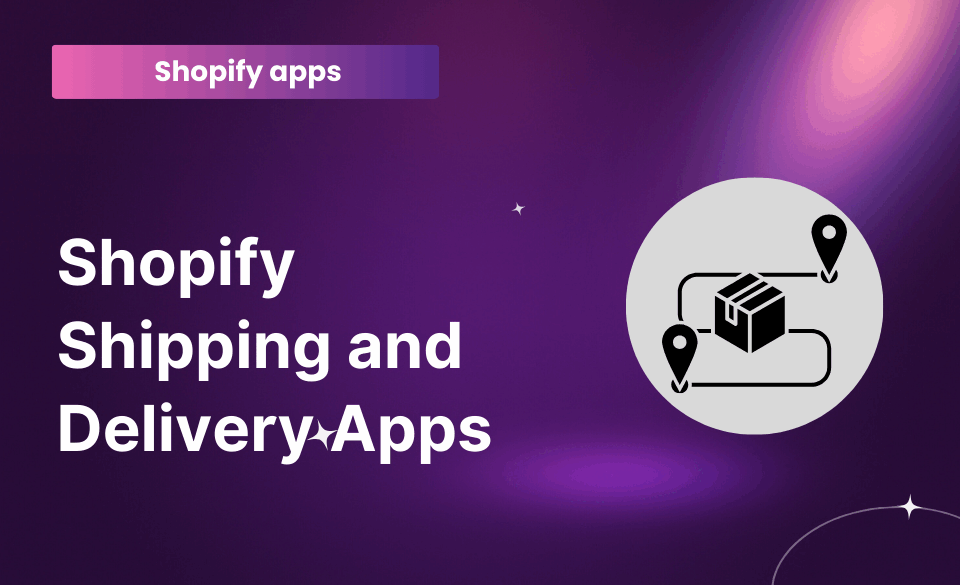
Small Business Referral Program: Best Practices & Best Examples
26 July, 2024
40 Best Referral Program Examples by Industry for 2024
2 August, 2024Referral links are a great way to promote a Shopify shop. You may unleash exponential growth and build a strong customer base by encouraging customers to tell their network about your store.
Here, we’ll explain what referral links are, why they’re useful, and how to create them in your Shopify store.
What Is A Referral Link?
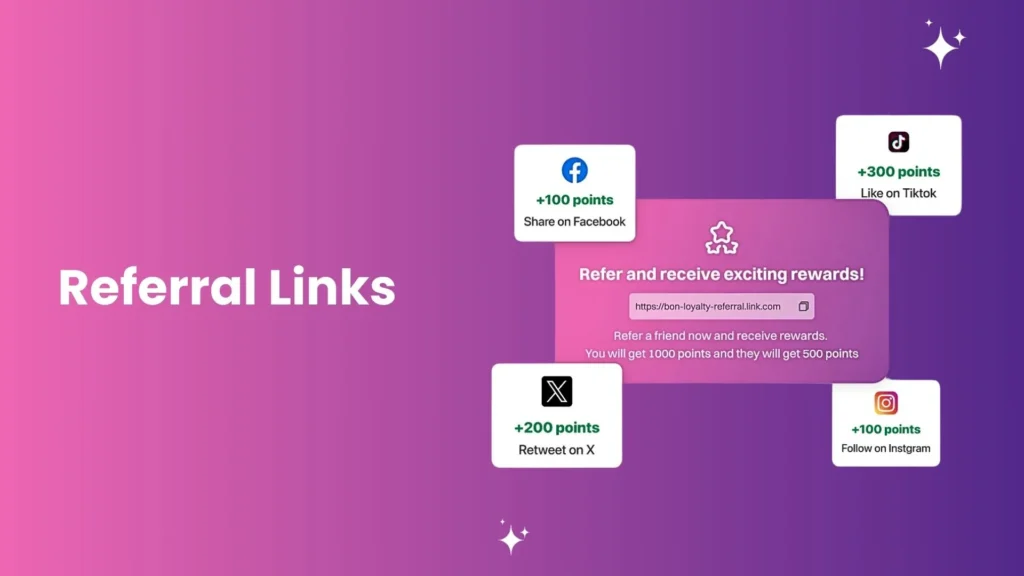
A referral link is a unique URL with a code that allows existing customers to share your brand with friends and family. This shareable link is like your customer’s personal invitation to your store with the key benefits below:
- Drive traffic to your store.
- Increased customer acquisition by attracting prospective customers and using your existing customers’ networks.
- Encouraging word-of-mouth marketing through referral links boosts your brand’s visibility.
Reference links define the essence of referral marketing. This is a proactive strategy based on the enthusiasm of your present customers to attract additional ones.
How Do Referral Links Work?
We have simplified the referral link process through the following 4 steps:
First, generate unique links tied to the customer account. This link contains a special code that identifies the referrer.
The second step is to distribute the referral links to the referred. Customers share their referral links with friends, family, or social media followers, inviting them to check out your store.
The third step involves tracking and analytics. The code is saved in the user’s browser’s cookies when they click on the referral link. If the initial consumer makes a purchase, the system keeps note of the recommendation and credits them with the transaction.
Finally, rewarding referrers is based on the predetermined reward structure. The referring customer receives incentives like discounts, store credit, or free products.
Benefits Of Using Referral Links For Shopify Stores
Referral links are a planned and natural approach for Shopify business owners to grow their consumer base. Using recommendation links might assist your brand in the following ways:
- Cost-effective marketing tactic since referral programs don’t depend on expensive advertising efforts to spread the word. It relies on your happy customers to do it.
- Increased conversion rates as 92% of customers trust friends and family more than ads. Also, customers who friends suggest are more inclined to buy. They trust your brand already.
- Enhanced customer loyalty by giving rewards to customers who bring new customers. It makes them more likely to promote the brand and tell their network about good experiences.
- Utilizing detailed tracking and data, you can personalize marketing to the actions and interests of your customers.
Are you convinced by the potential of referral links? We’ll look at how to make and use efficient recommendation links in the future section.
How To Create Referral Links For Shopify Stores?
In this section, we will show you how to create a referral link for the Shopify store and suggest some referral program apps:
5 Ways To Create Referral Links For Shopify Stores
Here are five effective methods to create referral links for your Shopify store:
Option 1: Manual Creation With URL Parameters
In the image below is the format of referral links with URL parameters:
- Base URL: This is the main address of the website (like bonloyalty.com/signup), without any other pieces of information.
- Code for Referral: A unique number that is given to each sender (like 4e4wgp9).
- Referral Source: This is an extra term that tells you where the referral link was shared (like “copy.”)
You can manually create and track reference links with these tools:
- Bitly: Create shortened, branded links with basic tracking capabilities.
- TinyURL: Generate concise URLs for easy sharing.
- Google Analytics: Use custom URL parameters to track referral traffic and conversions. This requires advanced technical knowledge.
While this method requires technical expertise, it offers complete customization. This approach provides granular track referrals and control over referral data.
Option 2: Leverage Shopify Apps
Some Shopify apps (like BON Loyalty) are great at running loyalty programs and making it simple for people to make links that lead to other people’s websites.
In another section, we will provide detailed instructions on how to use BON Loyalty to create referral links.
Option 3: Utilize External Referral Platforms
Connect your Shopify store to external referral platforms for more features and functions. Often, these platforms offer full data, protection against scams, and rewards for referrals that can be changed to fit your needs.
We will introduce some external referral platforms in another section.
Option 4: Develop A Custom Referral System
Businesses with specific needs or technical know-how can use Shopify’s API to create the recommendation system. This method gives you full control over how the referral program looks and works.
This article explains how to create a Shopify API custom app in 3 steps.
Option 5: Partner with Referral Marketing Agencies
Partnering with a link advertising agency can be helpful for companies that want to take a hands-off approach. These companies create and run referral programs as their main business. They can help you improve your campaign by giving you advice and tools.
To use reference links effectively, choose the best method that fits your technical skills, budget, and customization needs.
An Easy Guide To Creating A Referral Link Using The BON Loyalty App
BON Loyalty streamlines the process of designing and running Shopify shops’ referral programs.
Step 1: Install And Set Up The app
Go to the Shopify App Store and type in “BON Loyalty.“ After that, install the app and activate it within your Shopify shop by following the on-screen instructions.
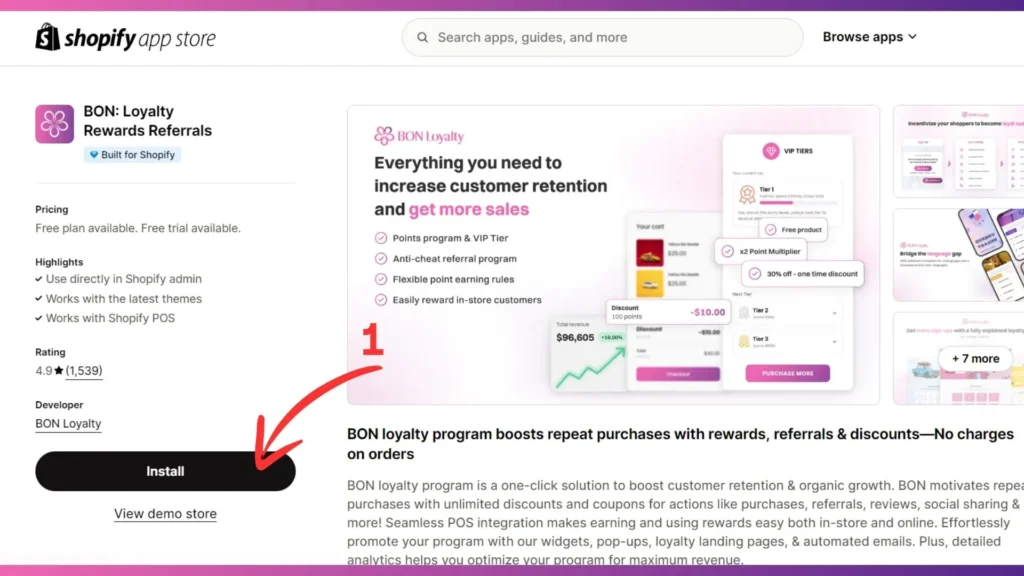
Step 2: Set up rewards referral and incentives
Return to Shopify Admin after you have installed BON Loyalty and launch the BON app from the left vertical menu. Then choose from the drop-down option “Point program”.
Within the Referral program area, proceed to choose the “Set up” button. In the next step, you’ll find the referral program setup.
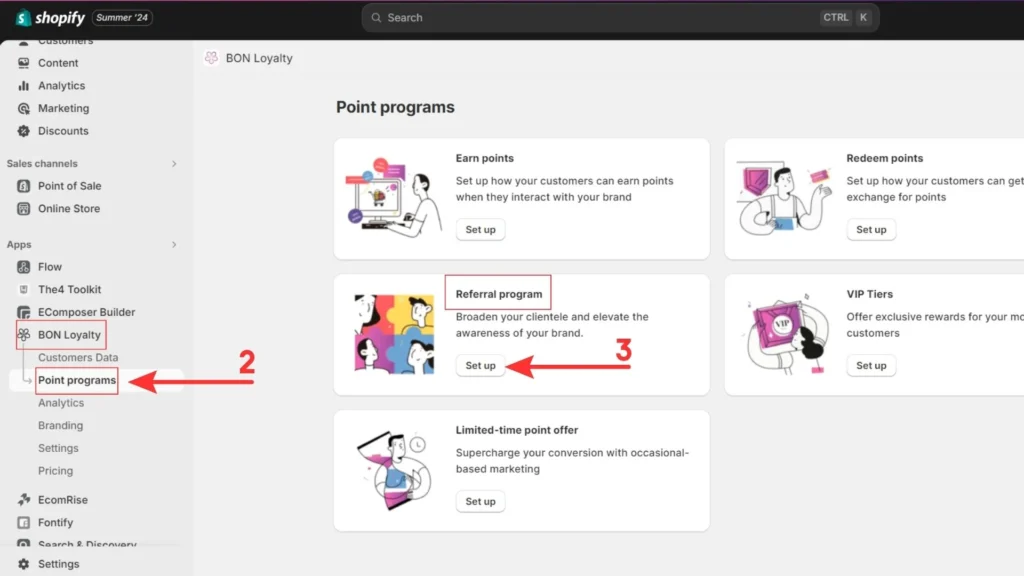
To choose a reward for the referrer, click the “Edit” button in the “Referrer reward” section.
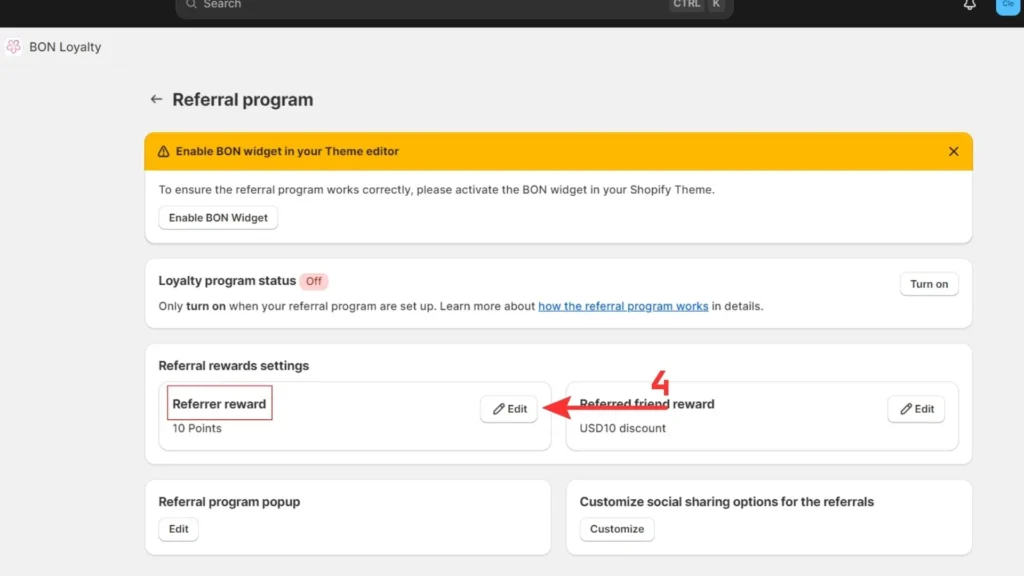
To set up a reward for the referred person, click “Edit” in the Referred Friend Reward section.
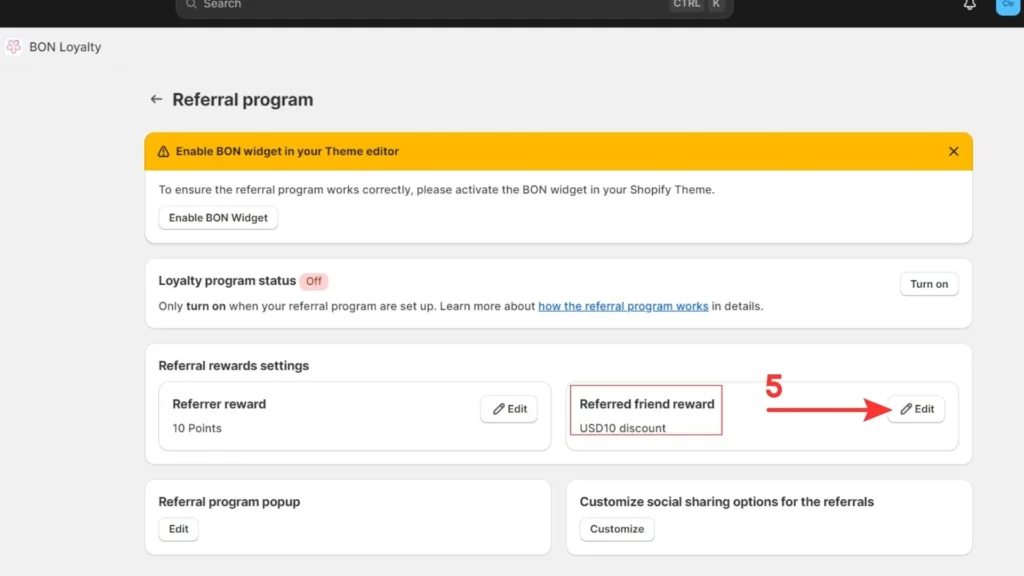
Here, you can set up:
- Reward types include points, amount discounts, percentage discounts, free shipping discounts, and free product discounts.
- Reward title is the name of your referral program for Shopify stores.
- Reward value is the value of the reward. For example, if you choose the reward type as points, the reward value can be 10 points.
- The minimum requirement is the minimum purchase value if you choose a discount as a reward.
- Use conditions are products that apply to Shopify referral marketing strategy (optional).
- Combinations with other promotions (optional).
- Reward expiration (optional).
Additionally, you can display the program as a referral pop-up.
Once you’re set-up, go back to the Referral program setup page and click “Turn on” to set up your referral program to show up in your Shopify stores.
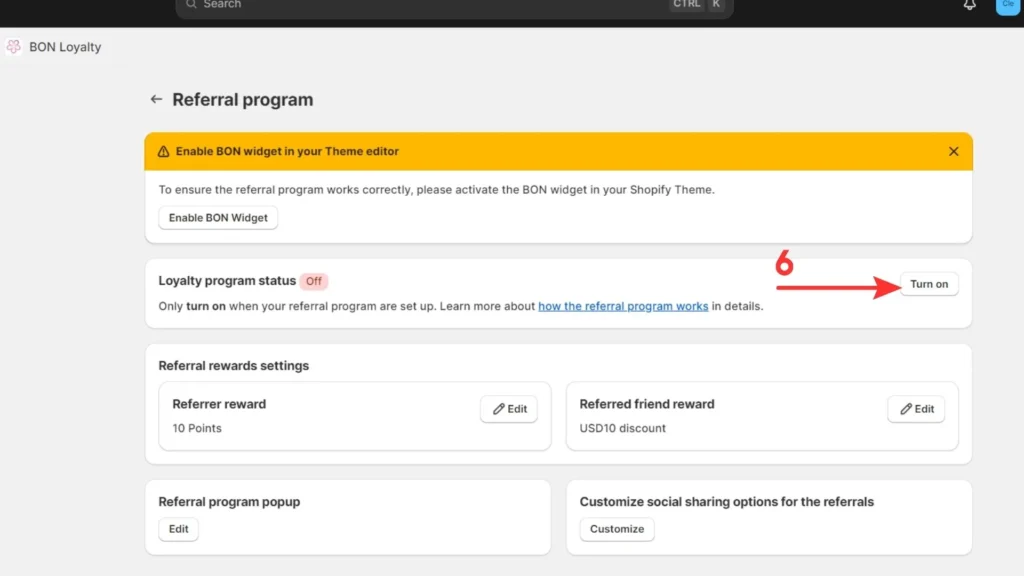
Detailed instructions: How do you set up the referral program with BON Loyalty?
Step 3: Test the referral link
To test the recommendation link you created with BON Loyalty, you must access your Shopify store using the customer interface.
Then, go to the Shopify referral widget or loyalty page and select the Referral program tab
You will need to create a member account to see the referral link. If they are a customer, they need to copy and paste this recommendation link to the person they want to refer.
After the referred person clicks on this link and makes an order or signs it, the transaction will be statistically recorded and reported in the “Analytics” feature of the BON Loyalty app.
Read more: How does the BON Analytics feature work?
Choosing The Right Shopify Referral Program App
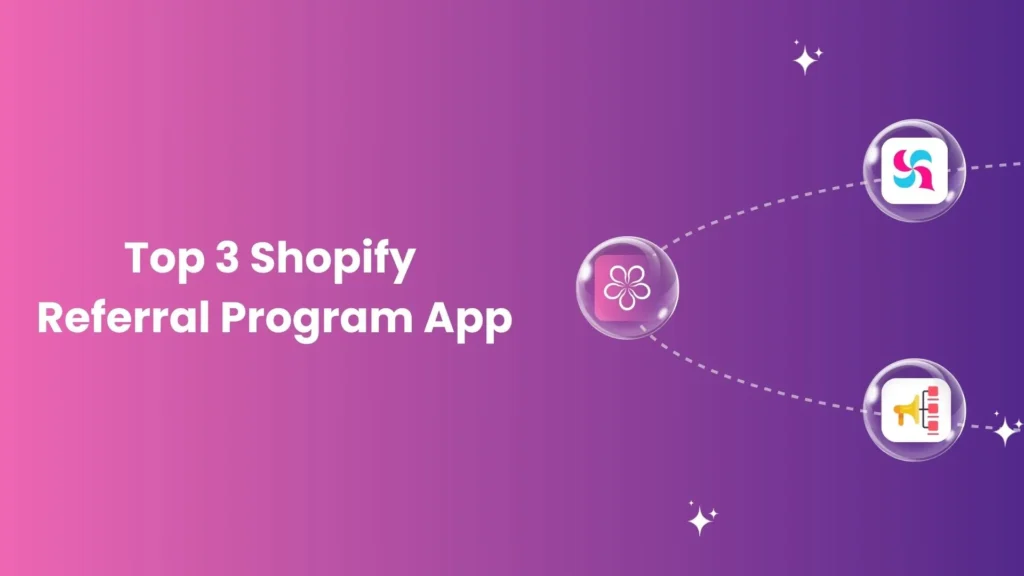
Here, three Shopify referral app options—BON Loyalty, ReferralCandy, and ReferrLy Affiliate Marketing—are compared.
- BON Loyalty excels in customization and flexibility. It allows you to tailor referral programs with features like language options, diverse reward types, and custom rewards. Its referral pop-ups and social sharing functionalities are extra advantages.
- ReferralCandy prioritizes ease of use and boasts a user-friendly interface. Its automation capabilities streamline referral program management, including affiliate link generation and fraud protection.
- ReferrLy Affiliate Marketing is an all-in-one approach that allows you to leverage the Shopify influencer program alongside traditional referrals.
The ideal app for your Shopify business ultimately depends on your unique requirements. When choosing a product, consider customer service, feature availability, cost, and convenience.
Examples Of Successful Referral Programs
In this section, we will discuss two case study referral programs and analyze why they are successful.
Harry’s referral program
Harry’s, a high-end razor brand, set up a referral program that 77% of the emails gathered were from recommendations, around 20,000 people sent around 65,000 referrals.
Their referral page has easy-to-share buttons and a progress bar that lets referrers see how many recommendations they have and their rewards status. At the lowest level, 5 recommendations, Harry’s product was given away: free shave cream.
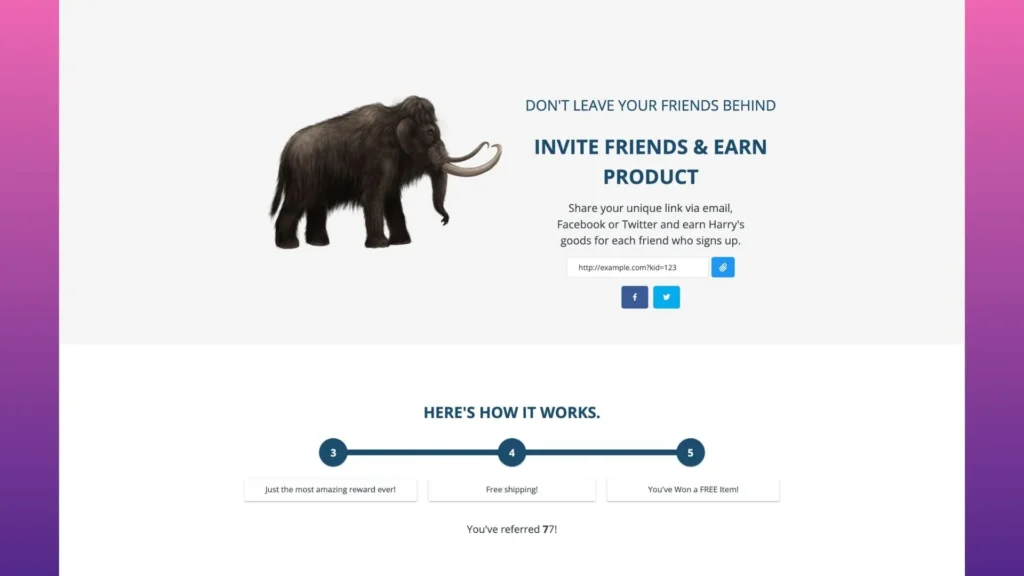
So, why is success?
All employees helped get the word out about the program at first. At the time, employees were told to send the news about the new product to their friends, family, and anyone else they knew.
Finally, a viral loop happens when someone tells their friends about a brand, and those friends then tell their friends, and so on. It’s a never-ending circle that keeps going. Harry’s used this method to make a viral loop that keeps people sharing and getting new leads.
GYMBROs’s referral program
We will next examine the case study of GYMBROs, an Australian company that offers vitamins and other products for the gym. GYMBROs’s referral program is much less complicated than Harry’s. Each referral will earn 100 loyalty points for both the referrer and the recommended individual.
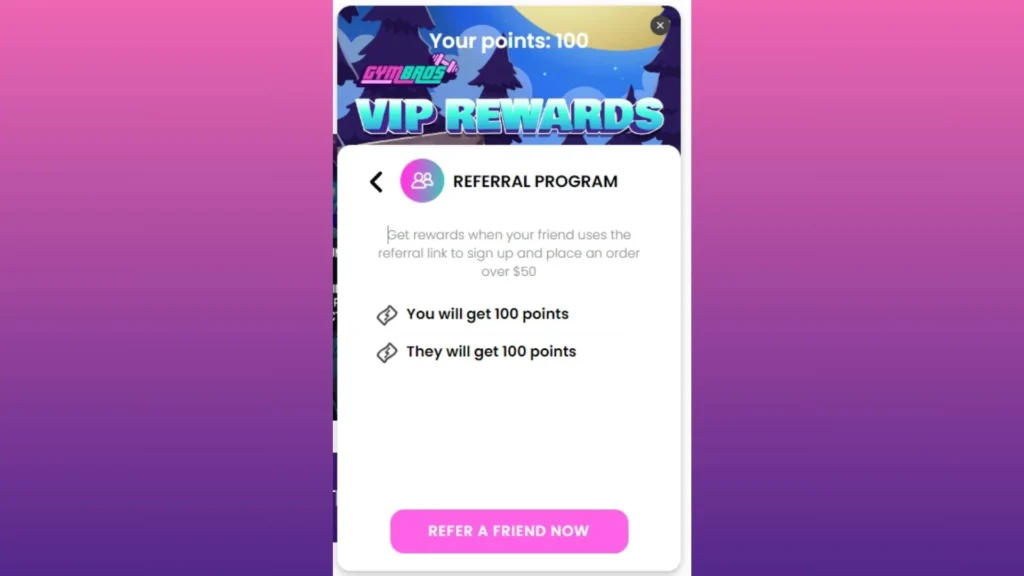
So, why is it successful?
First, GYMBROs used BON Loyalty’s referral pop-up feature to ensure that information about loyalty benefits and the referral program was displayed throughout the customer journey.
Second, we must mention the ease of utilizing the program. If the referred uses a recommendation link to sign up for an account and place an order, both the referrer and the referred will get benefits.
Lastly, reward points can be redeemed for vouchers or things only available from that brand. That makes GYMBROs rewards extremely valuable.
Read more: 14 Case Studies Of Successful Small Business Referral Programs
4 Referral Program Tips For Maximizing The Effectiveness
Making attractive referral links is only the beginning. In order to get the most out of your referral program, you must put in place methods that promote sharing and increase conversions. Let’s examine some tried-and-true strategies to increase your referral links’ efficacy.
1. Promote Referral Links Across Multiple Channels
Referrals from social media marketing generated roughly 31% of new business. You should ask your customers to share your referral links on their social networks. BON Loyalty’s social sharing feature can help you do this.
You should prominently display recommendation links on your website, placing them in the header, footer, or dedicated referral page.
You can also create a landing page for your referral program. With a specialized landing page, you can discuss the benefits of your referral program without any other information getting in the way.
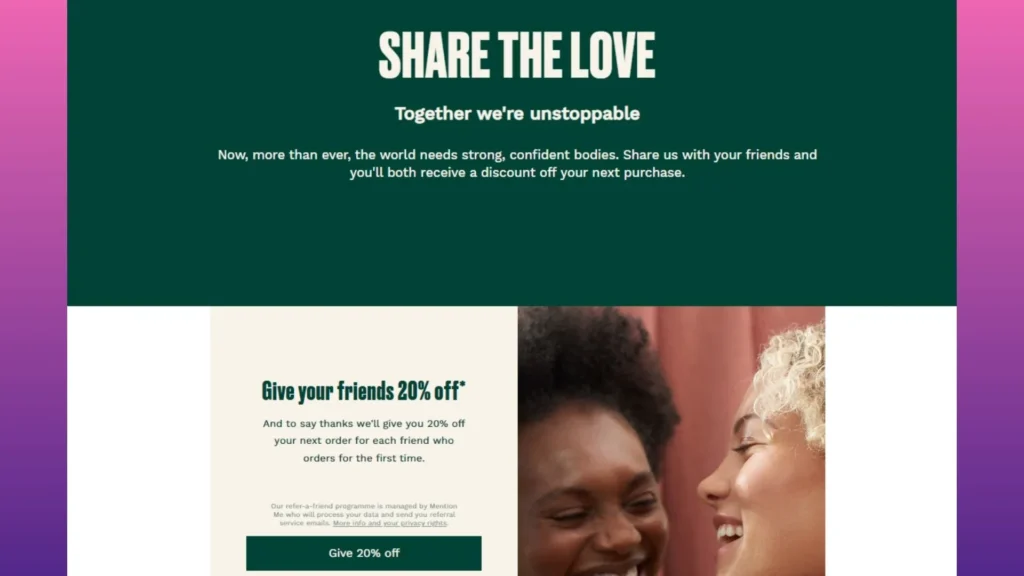
2. Offer Irresistible Rewards
To maximize participation and drive referrals, consider these compelling reward options:
Product-Based Rewards:
- Free products with their next order or discounts for their next purchase or a free product.
- Tiered rewards as the number of referrals grows.
- Exclusive product access to limited edition or new products.
Monetary Rewards:
- Store credit for each successful referral.
- Cashback for customers who prefer monetary rewards.
Gamification and Tiered Rewards:
- A point system for referrals allows customers to redeem rewards at different tiers.
- Digital badges and recognition for referral milestones.
For example, tech-savvy customers might want new products before anyone else, while fashion-conscious customers might want deals or free shipping.
3. Regularly Update And Test Referral Links
You can use the A/B Test to test experiments with different link designs, call-to-actions, or reward offers to optimize performance. ReferralCandy, which we introduced above, allows you to A/B test different referral rewards, referral link designs, and email templates. Then, analyze the results to identify the most effective variations.
Don’t forget to check for any technical issues that prevent links from functioning correctly.
4. Engage With Customers And Encourage Participation
You may respond to often-asked customer inquiries by creating FAQs about your referral program. Additionally, as they are the most likely to become recommendations, you may explain your referral program and send targeted emails to your frequent shopping consumers.
Get inspired by One Skin, the Pakistani skin care products brand that sent out introductory email marketing and dedicated instructions about its referral program.
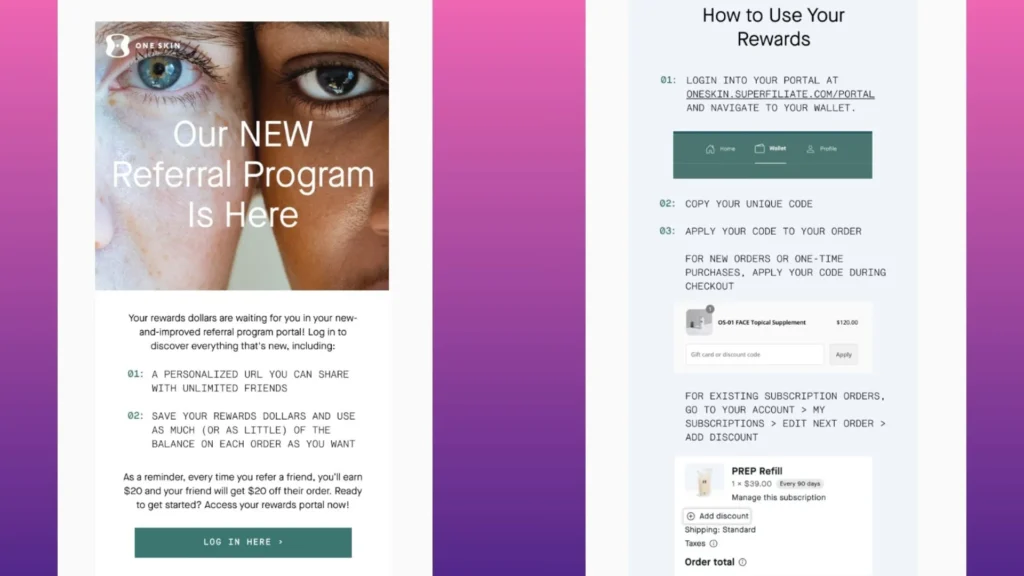
Conclusion
You may effectively use the potential of referral marketing and establish a prosperous referral program for your Shopify business by adhering to the instructions provided in this tutorial. Remember that giving solid incentives makes it simple for users to share.
Also, consistently refining your strategy is the key to enhancing the effect of your referral program.
Ready to get started? BON Loyalty offers a free forever package with no extra fees for up to 250 orders. This is a great chance to see what a Shopify customer referral program is like and if it works for you without spending a budget.
Lindsey Nguyen is a Content Marketing Specialist at BON Loyalty, specializing in digital marketing and eCommerce. At BON Loyalty, she crafts content that empowers Shopify store owners to build and sustain thriving customer relationships through innovative loyalty programs. Her articles, often featured on the BON Loyalty blog, provide valuable strategies and insights that help businesses enhance customer loyalty and increase customer lifetime value.
